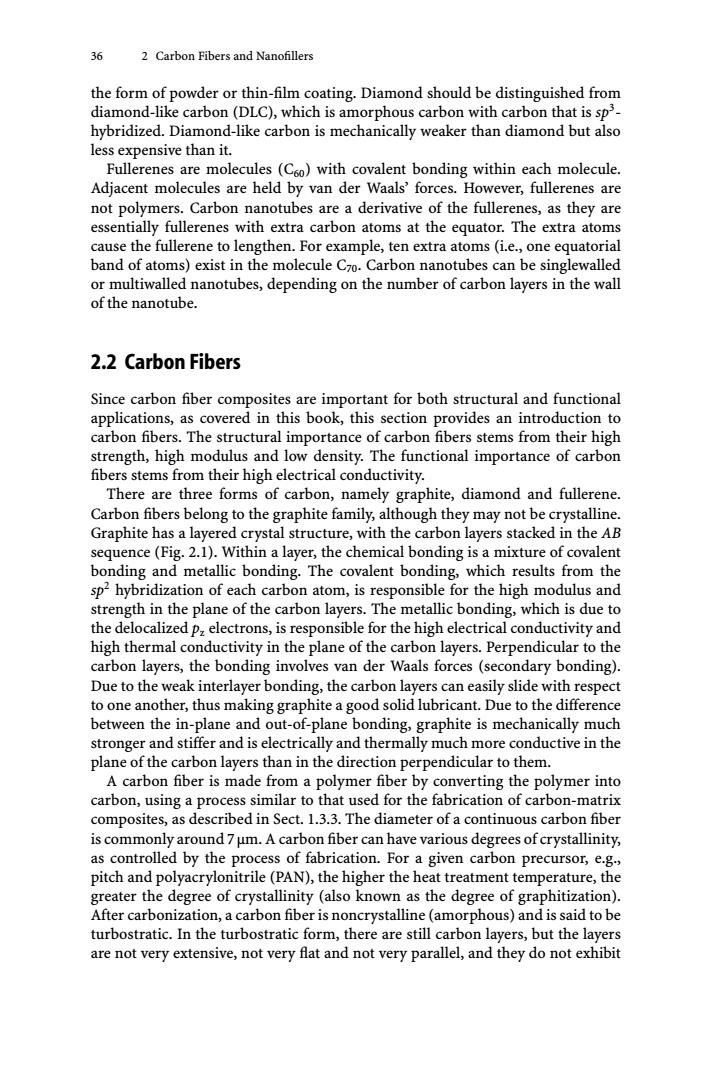正在加载图片...

36 2 Carbon Fibers and Nanofillers the form of powder or thin-film coating.Diamond should be distinguished from diamond-like carbon (DLC),which is amorphous carbon with carbon that is sp'- hybridized.Diamond-like carbon is mechanically weaker than diamond but also less expensive than it. Fullerenes are molecules (C6o)with covalent bonding within each molecule. Adjacent molecules are held by van der Waals'forces.However,fullerenes are not polymers.Carbon nanotubes are a derivative of the fullerenes,as they are essentially fullerenes with extra carbon atoms at the equator.The extra atoms cause the fullerene to lengthen.For example,ten extra atoms(i.e.,one equatorial band of atoms)exist in the molecule C7o.Carbon nanotubes can be singlewalled or multiwalled nanotubes,depending on the number of carbon layers in the wall of the nanotube. 2.2 Carbon Fibers Since carbon fiber composites are important for both structural and functional applications,as covered in this book,this section provides an introduction to carbon fibers.The structural importance of carbon fibers stems from their high strength,high modulus and low density.The functional importance of carbon fibers stems from their high electrical conductivity. There are three forms of carbon,namely graphite,diamond and fullerene. Carbon fibers belong to the graphite family,although they may not be crystalline. Graphite has a layered crystal structure,with the carbon layers stacked in the AB sequence(Fig.2.1).Within a layer,the chemical bonding is a mixture of covalent bonding and metallic bonding.The covalent bonding,which results from the sp2 hybridization of each carbon atom,is responsible for the high modulus and strength in the plane of the carbon layers.The metallic bonding,which is due to the delocalized p electrons,is responsible for the high electrical conductivity and high thermal conductivity in the plane of the carbon layers.Perpendicular to the carbon layers,the bonding involves van der Waals forces (secondary bonding). Due to the weak interlayer bonding,the carbon layers can easily slide with respect to one another,thus making graphite a good solid lubricant.Due to the difference between the in-plane and out-of-plane bonding,graphite is mechanically much stronger and stiffer and is electrically and thermally much more conductive in the plane of the carbon layers than in the direction perpendicular to them. A carbon fiber is made from a polymer fiber by converting the polymer into carbon,using a process similar to that used for the fabrication of carbon-matrix composites,as described in Sect.1.3.3.The diameter of a continuous carbon fiber is commonly around 7 um.A carbon fiber can have various degrees of crystallinity, as controlled by the process of fabrication.For a given carbon precursor,e.g, pitch and polyacrylonitrile(PAN),the higher the heat treatment temperature,the greater the degree of crystallinity (also known as the degree of graphitization). After carbonization,a carbon fiber is noncrystalline(amorphous)and is said to be turbostratic.In the turbostratic form,there are still carbon layers,but the layers are not very extensive,not very flat and not very parallel,and they do not exhibit36 2 Carbon Fibers and Nanofillers the form of powder or thin-film coating. Diamond should be distinguished from diamond-like carbon (DLC), which is amorphous carbon with carbon that is sp3- hybridized. Diamond-like carbon is mechanically weaker than diamond but also less expensive than it. Fullerenes are molecules (C60) with covalent bonding within each molecule. Adjacent molecules are held by van der Waals’ forces. However, fullerenes are not polymers. Carbon nanotubes are a derivative of the fullerenes, as they are essentially fullerenes with extra carbon atoms at the equator. The extra atoms cause the fullerene to lengthen. For example, ten extra atoms (i.e., one equatorial band of atoms) exist in the molecule C70. Carbon nanotubes can be singlewalled or multiwalled nanotubes, depending on the number of carbon layers in the wall of the nanotube. 2.2 Carbon Fibers Since carbon fiber composites are important for both structural and functional applications, as covered in this book, this section provides an introduction to carbon fibers. The structural importance of carbon fibers stems from their high strength, high modulus and low density. The functional importance of carbon fibers stems from their high electrical conductivity. There are three forms of carbon, namely graphite, diamond and fullerene. Carbon fibers belong to the graphite family, although they may not be crystalline. Graphite has a layered crystal structure, with the carbon layers stacked in the AB sequence (Fig. 2.1). Within a layer, the chemical bonding is a mixture of covalent bonding and metallic bonding. The covalent bonding, which results from the sp2 hybridization of each carbon atom, is responsible for the high modulus and strength in the plane of the carbon layers. The metallic bonding, which is due to the delocalized pz electrons, is responsible for the high electrical conductivity and high thermal conductivity in the plane of the carbon layers. Perpendicular to the carbon layers, the bonding involves van der Waals forces (secondary bonding). Due to the weak interlayer bonding, the carbon layers can easily slide with respect to one another, thus making graphite a good solid lubricant. Due to the difference between the in-plane and out-of-plane bonding, graphite is mechanically much stronger and stiffer and is electrically and thermally much more conductive in the plane of the carbon layers than in the direction perpendicular to them. A carbon fiber is made from a polymer fiber by converting the polymer into carbon, using a process similar to that used for the fabrication of carbon-matrix composites, as described in Sect. 1.3.3. The diameter of a continuous carbon fiber is commonly around 7μm. A carbon fiber can have various degrees of crystallinity, as controlled by the process of fabrication. For a given carbon precursor, e.g., pitch and polyacrylonitrile (PAN), the higher the heat treatment temperature, the greater the degree of crystallinity (also known as the degree of graphitization). After carbonization, a carbon fiber is noncrystalline (amorphous) and is said to be turbostratic. In the turbostratic form, there are still carbon layers, but the layers are not very extensive, not very flat and not very parallel, and they do not exhibit